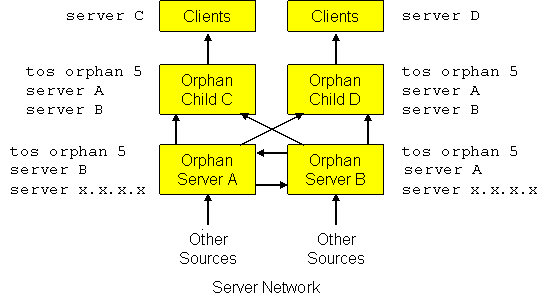Sometimes an NTP subnet becomes isolated from all UTC sources such as local reference clocks or Internet time servers. In such cases it may be necessary that the subnet servers and clients remain synchronized to a common timescale, not necessarily the UTC timescale. Previously, this function was provided by the local clock driver to simulate a UTC source. A server with this driver could be used to synchronize other hosts in the subnet directly or indirectly.
There are many disadvantages using the local clock driver, primarily that the subnet is vulnerable to single-point failures and multiple server redundancy is not possible. Orphan mode is intended to replace the local clock driver. It provides a single simulated UTC source with multiple servers and provides seamless switching as servers fail and recover.
A common configuration for private networks includes one or more core servers operating at the lowest stratum. Good practice is to configure each of these servers as backup for the others using server mode. As long as at least one core server can reach a UTC source, the entire subnet can synchronize to it.
If no UTC sources are available to any core server, one of them can provide a simulated UTC source for all other hosts in the subnet. However, only one core server can simulate the UTC source and all direct dependents, called orphan children, must select the same server, called the orphan parent.
Hosts sharing the same common subnet, including potential orphan parents
and potential orphan children, can be enabled for orphan mode using the
orphan stratum option of the tos command,
where stratum is some stratum less than 16 and greater than any
anticipated stratum that might occur with configured Internet time
servers. However, sufficient headroom should remain so every subnet host
dependent on the orphan children has stratum less than 16. Where no
associations for other servers or reference clocks are configured, the
orphan stratum can be set to 1. These are the same considerations that
guide the local clock driver stratum selection.
In order to avoid premature enabling orphan mode, a holdoff delay occurs
when the daemon is first started and when all sources have been lost
after that. The delay is intended to allow time for other sources to
become reachable and selectable. Only when the delay has expired with no
sources will orphan mode be enabled. By default the delay is 300 s (five
minutes), but this can be changed using the orphanwait option of the
tos command.
A orphan parent with no sources shows reference ID LOOP if operating at stratum 1 and 127.0.0.1 (IPv4 loopback address) otherwise. While ordinary NTP clients use a selection metric based on delay and dispersion, orphan children use a metric computed from the IP address of each core server. Each orphan child chooses as the orphan parent as the core server with the smallest metric. This guarantees that all orphan children choose the same orphan parent.
For orphan mode to work well, each core server with available sources should operate at the same stratum. All core servers and orphan children should include the same tos command in the configuration file. Each orphan child should include in the configuration file all core servers.

Figure 1. Orphan server Configuration
For example, consider the server network configuration in Figure 1, where two or more campus primary or secondary (stratum 2) servers are configured with reference clocks or public Internet primary servers and with each other using server mode. With this configuration a server that loses all sources continues to discipline the system clock using the other servers as backup. Only the core servers and orphan children need to be enabled for orphan mode.